Taxation of Various Income and Deductions for Tom Lee
VerifiedAdded on 2022/11/28
|6
|1548
|65
AI Summary
This guide provides a detailed explanation of the taxation of various types of income and deductions for Tom Lee. It covers topics such as sales of clothes, rental income, interest on bank deposits, dividends, superannuation contributions, and more. The guide also includes information on the applicable sections of the Income Tax Assessment Act 1997 and relevant court cases. It is a valuable resource for individuals looking to understand their tax obligations.
Contribute Materials
Your contribution can guide someone’s learning journey. Share your
documents today.
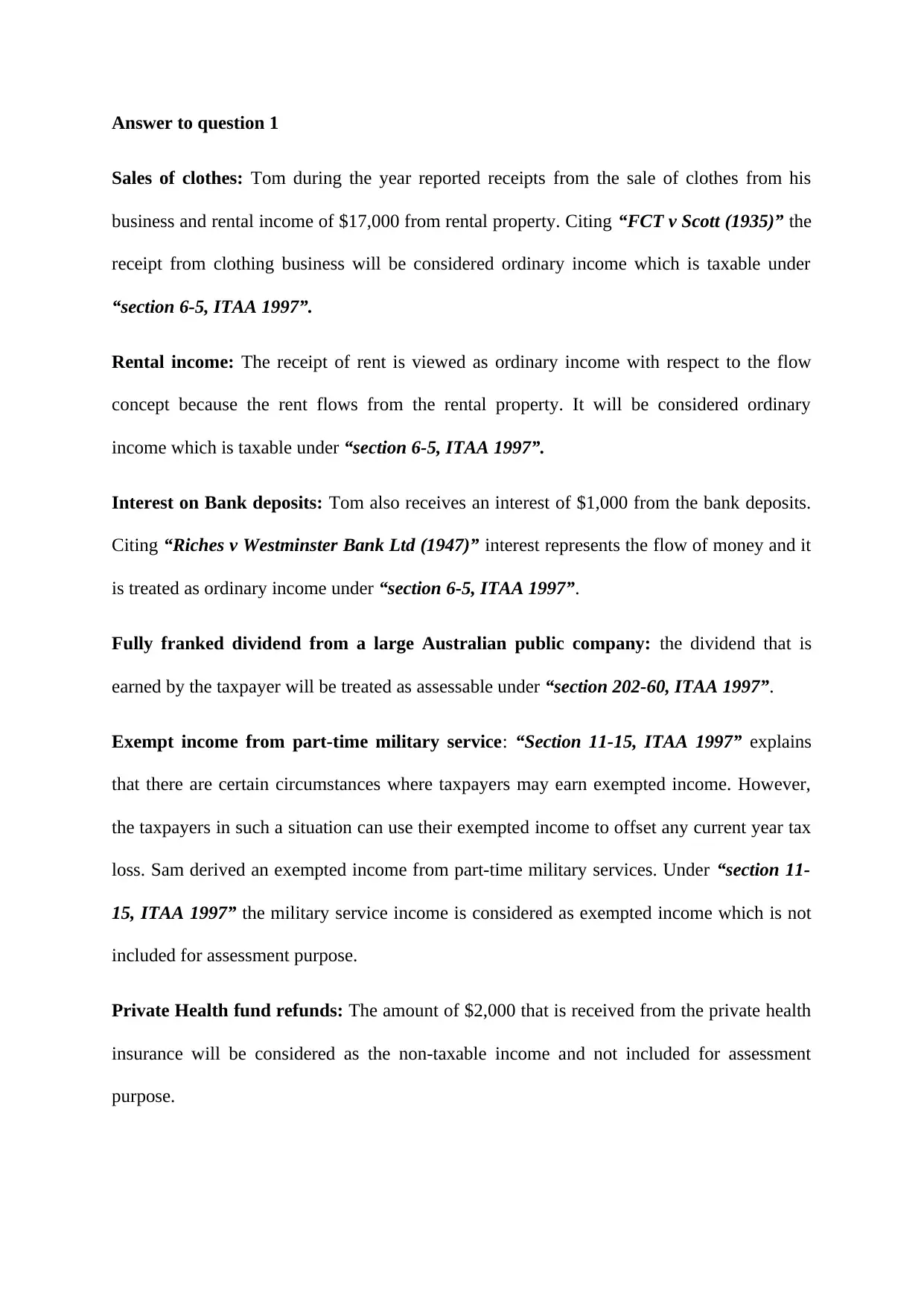
Answer to question 1
Sales of clothes: Tom during the year reported receipts from the sale of clothes from his
business and rental income of $17,000 from rental property. Citing “FCT v Scott (1935)” the
receipt from clothing business will be considered ordinary income which is taxable under
“section 6-5, ITAA 1997”.
Rental income: The receipt of rent is viewed as ordinary income with respect to the flow
concept because the rent flows from the rental property. It will be considered ordinary
income which is taxable under “section 6-5, ITAA 1997”.
Interest on Bank deposits: Tom also receives an interest of $1,000 from the bank deposits.
Citing “Riches v Westminster Bank Ltd (1947)” interest represents the flow of money and it
is treated as ordinary income under “section 6-5, ITAA 1997”.
Fully franked dividend from a large Australian public company: the dividend that is
earned by the taxpayer will be treated as assessable under “section 202-60, ITAA 1997”.
Exempt income from part-time military service: “Section 11-15, ITAA 1997” explains
that there are certain circumstances where taxpayers may earn exempted income. However,
the taxpayers in such a situation can use their exempted income to offset any current year tax
loss. Sam derived an exempted income from part-time military services. Under “section 11-
15, ITAA 1997” the military service income is considered as exempted income which is not
included for assessment purpose.
Private Health fund refunds: The amount of $2,000 that is received from the private health
insurance will be considered as the non-taxable income and not included for assessment
purpose.
Sales of clothes: Tom during the year reported receipts from the sale of clothes from his
business and rental income of $17,000 from rental property. Citing “FCT v Scott (1935)” the
receipt from clothing business will be considered ordinary income which is taxable under
“section 6-5, ITAA 1997”.
Rental income: The receipt of rent is viewed as ordinary income with respect to the flow
concept because the rent flows from the rental property. It will be considered ordinary
income which is taxable under “section 6-5, ITAA 1997”.
Interest on Bank deposits: Tom also receives an interest of $1,000 from the bank deposits.
Citing “Riches v Westminster Bank Ltd (1947)” interest represents the flow of money and it
is treated as ordinary income under “section 6-5, ITAA 1997”.
Fully franked dividend from a large Australian public company: the dividend that is
earned by the taxpayer will be treated as assessable under “section 202-60, ITAA 1997”.
Exempt income from part-time military service: “Section 11-15, ITAA 1997” explains
that there are certain circumstances where taxpayers may earn exempted income. However,
the taxpayers in such a situation can use their exempted income to offset any current year tax
loss. Sam derived an exempted income from part-time military services. Under “section 11-
15, ITAA 1997” the military service income is considered as exempted income which is not
included for assessment purpose.
Private Health fund refunds: The amount of $2,000 that is received from the private health
insurance will be considered as the non-taxable income and not included for assessment
purpose.
Secure Best Marks with AI Grader
Need help grading? Try our AI Grader for instant feedback on your assignments.
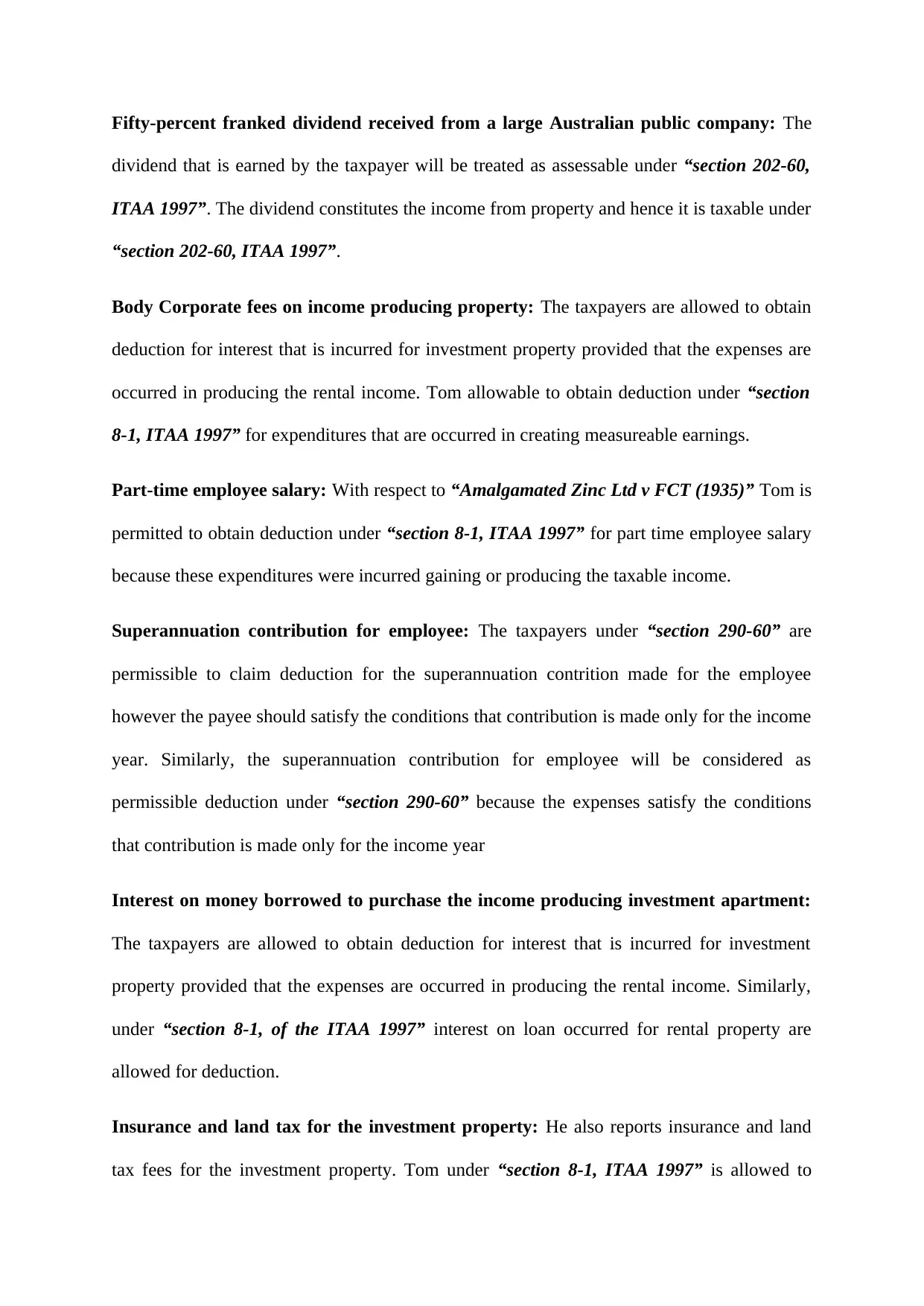
Fifty-percent franked dividend received from a large Australian public company: The
dividend that is earned by the taxpayer will be treated as assessable under “section 202-60,
ITAA 1997”. The dividend constitutes the income from property and hence it is taxable under
“section 202-60, ITAA 1997”.
Body Corporate fees on income producing property: The taxpayers are allowed to obtain
deduction for interest that is incurred for investment property provided that the expenses are
occurred in producing the rental income. Tom allowable to obtain deduction under “section
8-1, ITAA 1997” for expenditures that are occurred in creating measureable earnings.
Part-time employee salary: With respect to “Amalgamated Zinc Ltd v FCT (1935)” Tom is
permitted to obtain deduction under “section 8-1, ITAA 1997” for part time employee salary
because these expenditures were incurred gaining or producing the taxable income.
Superannuation contribution for employee: The taxpayers under “section 290-60” are
permissible to claim deduction for the superannuation contrition made for the employee
however the payee should satisfy the conditions that contribution is made only for the income
year. Similarly, the superannuation contribution for employee will be considered as
permissible deduction under “section 290-60” because the expenses satisfy the conditions
that contribution is made only for the income year
Interest on money borrowed to purchase the income producing investment apartment:
The taxpayers are allowed to obtain deduction for interest that is incurred for investment
property provided that the expenses are occurred in producing the rental income. Similarly,
under “section 8-1, of the ITAA 1997” interest on loan occurred for rental property are
allowed for deduction.
Insurance and land tax for the investment property: He also reports insurance and land
tax fees for the investment property. Tom under “section 8-1, ITAA 1997” is allowed to
dividend that is earned by the taxpayer will be treated as assessable under “section 202-60,
ITAA 1997”. The dividend constitutes the income from property and hence it is taxable under
“section 202-60, ITAA 1997”.
Body Corporate fees on income producing property: The taxpayers are allowed to obtain
deduction for interest that is incurred for investment property provided that the expenses are
occurred in producing the rental income. Tom allowable to obtain deduction under “section
8-1, ITAA 1997” for expenditures that are occurred in creating measureable earnings.
Part-time employee salary: With respect to “Amalgamated Zinc Ltd v FCT (1935)” Tom is
permitted to obtain deduction under “section 8-1, ITAA 1997” for part time employee salary
because these expenditures were incurred gaining or producing the taxable income.
Superannuation contribution for employee: The taxpayers under “section 290-60” are
permissible to claim deduction for the superannuation contrition made for the employee
however the payee should satisfy the conditions that contribution is made only for the income
year. Similarly, the superannuation contribution for employee will be considered as
permissible deduction under “section 290-60” because the expenses satisfy the conditions
that contribution is made only for the income year
Interest on money borrowed to purchase the income producing investment apartment:
The taxpayers are allowed to obtain deduction for interest that is incurred for investment
property provided that the expenses are occurred in producing the rental income. Similarly,
under “section 8-1, of the ITAA 1997” interest on loan occurred for rental property are
allowed for deduction.
Insurance and land tax for the investment property: He also reports insurance and land
tax fees for the investment property. Tom under “section 8-1, ITAA 1997” is allowed to
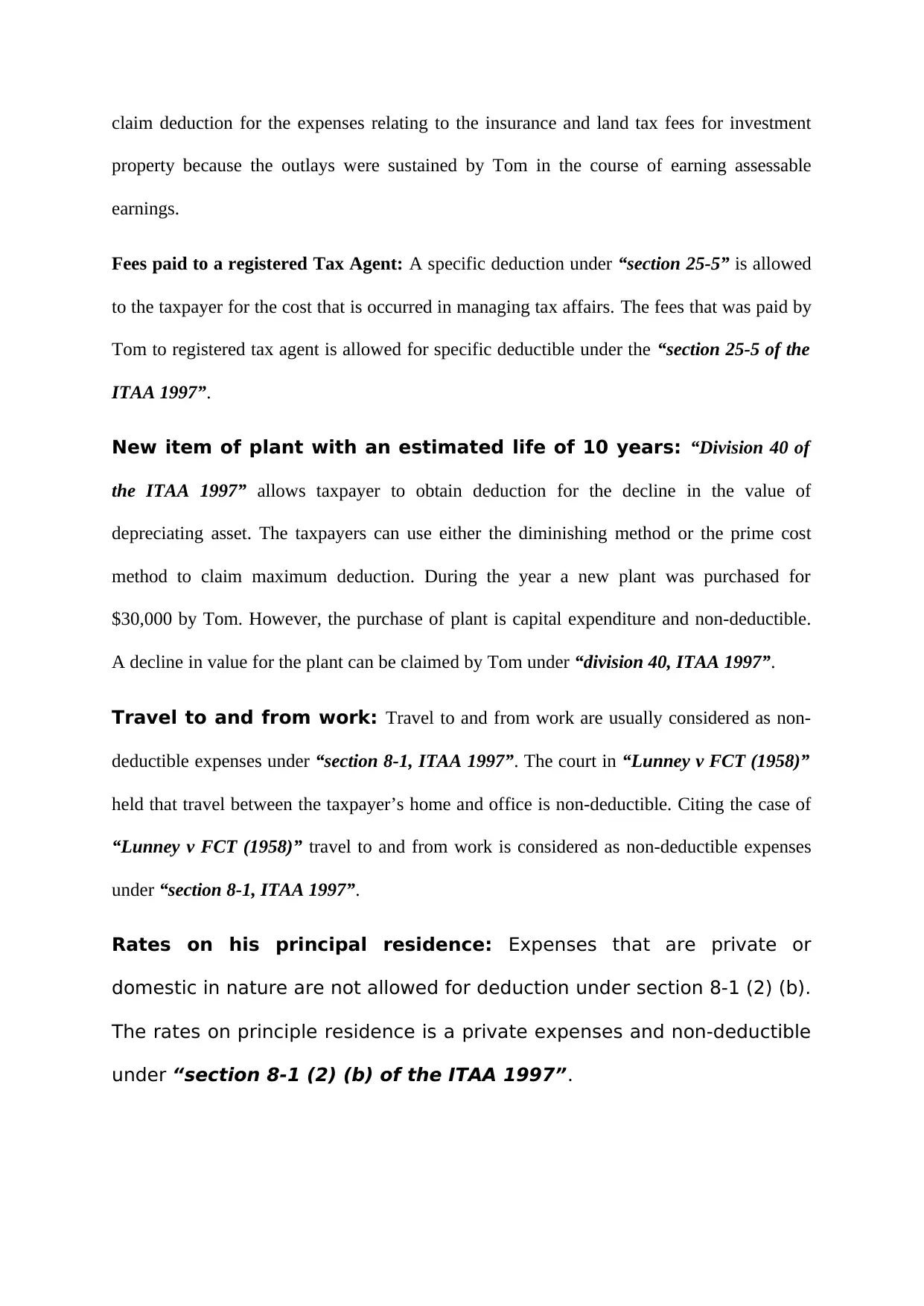
claim deduction for the expenses relating to the insurance and land tax fees for investment
property because the outlays were sustained by Tom in the course of earning assessable
earnings.
Fees paid to a registered Tax Agent: A specific deduction under “section 25-5” is allowed
to the taxpayer for the cost that is occurred in managing tax affairs. The fees that was paid by
Tom to registered tax agent is allowed for specific deductible under the “section 25-5 of the
ITAA 1997”.
New item of plant with an estimated life of 10 years: “Division 40 of
the ITAA 1997” allows taxpayer to obtain deduction for the decline in the value of
depreciating asset. The taxpayers can use either the diminishing method or the prime cost
method to claim maximum deduction. During the year a new plant was purchased for
$30,000 by Tom. However, the purchase of plant is capital expenditure and non-deductible.
A decline in value for the plant can be claimed by Tom under “division 40, ITAA 1997”.
Travel to and from work: Travel to and from work are usually considered as non-
deductible expenses under “section 8-1, ITAA 1997”. The court in “Lunney v FCT (1958)”
held that travel between the taxpayer’s home and office is non-deductible. Citing the case of
“Lunney v FCT (1958)” travel to and from work is considered as non-deductible expenses
under “section 8-1, ITAA 1997”.
Rates on his principal residence: Expenses that are private or
domestic in nature are not allowed for deduction under section 8-1 (2) (b).
The rates on principle residence is a private expenses and non-deductible
under “section 8-1 (2) (b) of the ITAA 1997”.
property because the outlays were sustained by Tom in the course of earning assessable
earnings.
Fees paid to a registered Tax Agent: A specific deduction under “section 25-5” is allowed
to the taxpayer for the cost that is occurred in managing tax affairs. The fees that was paid by
Tom to registered tax agent is allowed for specific deductible under the “section 25-5 of the
ITAA 1997”.
New item of plant with an estimated life of 10 years: “Division 40 of
the ITAA 1997” allows taxpayer to obtain deduction for the decline in the value of
depreciating asset. The taxpayers can use either the diminishing method or the prime cost
method to claim maximum deduction. During the year a new plant was purchased for
$30,000 by Tom. However, the purchase of plant is capital expenditure and non-deductible.
A decline in value for the plant can be claimed by Tom under “division 40, ITAA 1997”.
Travel to and from work: Travel to and from work are usually considered as non-
deductible expenses under “section 8-1, ITAA 1997”. The court in “Lunney v FCT (1958)”
held that travel between the taxpayer’s home and office is non-deductible. Citing the case of
“Lunney v FCT (1958)” travel to and from work is considered as non-deductible expenses
under “section 8-1, ITAA 1997”.
Rates on his principal residence: Expenses that are private or
domestic in nature are not allowed for deduction under section 8-1 (2) (b).
The rates on principle residence is a private expenses and non-deductible
under “section 8-1 (2) (b) of the ITAA 1997”.
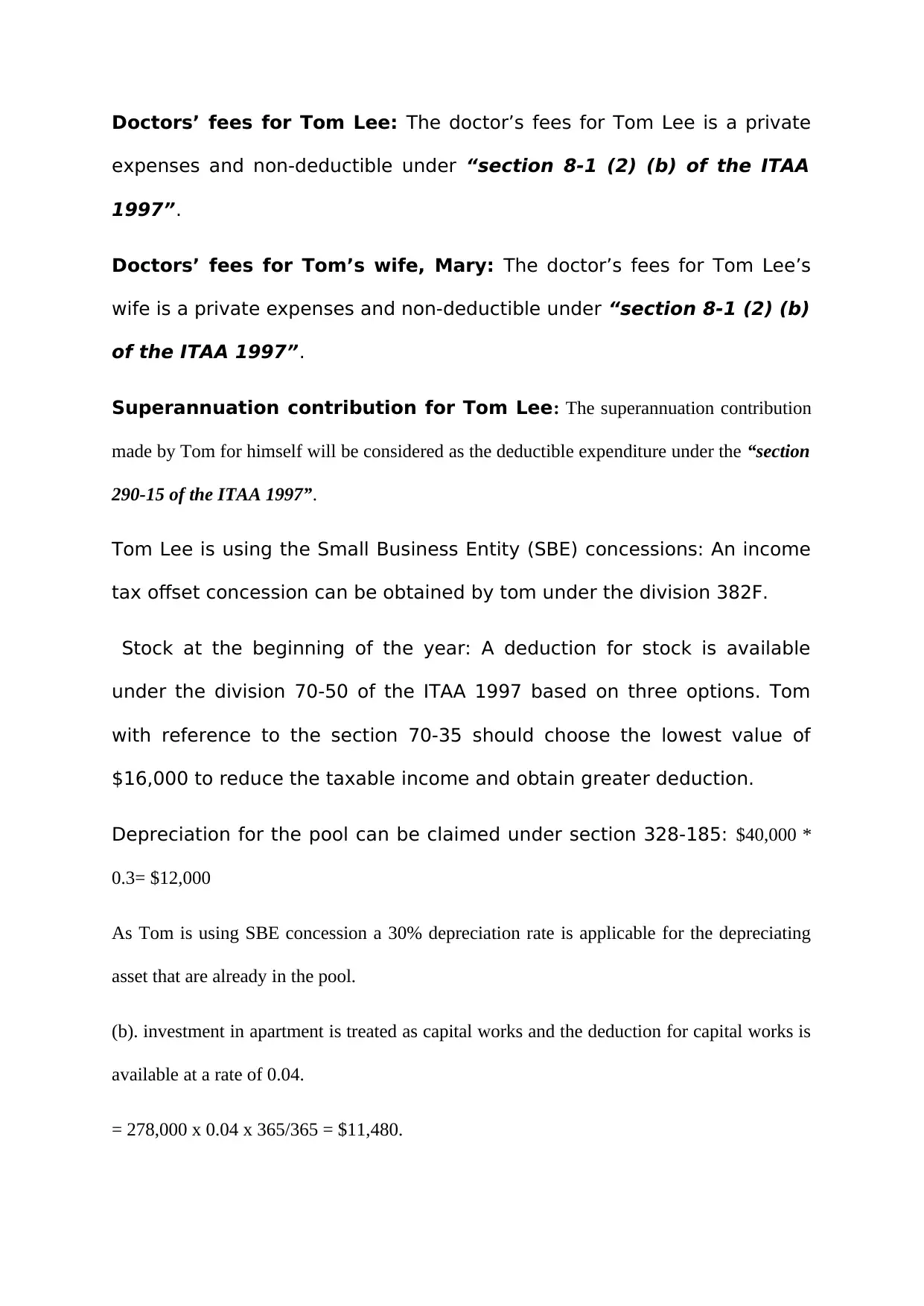
Doctors’ fees for Tom Lee: The doctor’s fees for Tom Lee is a private
expenses and non-deductible under “section 8-1 (2) (b) of the ITAA
1997”.
Doctors’ fees for Tom’s wife, Mary: The doctor’s fees for Tom Lee’s
wife is a private expenses and non-deductible under “section 8-1 (2) (b)
of the ITAA 1997”.
Superannuation contribution for Tom Lee: The superannuation contribution
made by Tom for himself will be considered as the deductible expenditure under the “section
290-15 of the ITAA 1997”.
Tom Lee is using the Small Business Entity (SBE) concessions: An income
tax offset concession can be obtained by tom under the division 382F.
Stock at the beginning of the year: A deduction for stock is available
under the division 70-50 of the ITAA 1997 based on three options. Tom
with reference to the section 70-35 should choose the lowest value of
$16,000 to reduce the taxable income and obtain greater deduction.
Depreciation for the pool can be claimed under section 328-185: $40,000 *
0.3= $12,000
As Tom is using SBE concession a 30% depreciation rate is applicable for the depreciating
asset that are already in the pool.
(b). investment in apartment is treated as capital works and the deduction for capital works is
available at a rate of 0.04.
= 278,000 x 0.04 x 365/365 = $11,480.
expenses and non-deductible under “section 8-1 (2) (b) of the ITAA
1997”.
Doctors’ fees for Tom’s wife, Mary: The doctor’s fees for Tom Lee’s
wife is a private expenses and non-deductible under “section 8-1 (2) (b)
of the ITAA 1997”.
Superannuation contribution for Tom Lee: The superannuation contribution
made by Tom for himself will be considered as the deductible expenditure under the “section
290-15 of the ITAA 1997”.
Tom Lee is using the Small Business Entity (SBE) concessions: An income
tax offset concession can be obtained by tom under the division 382F.
Stock at the beginning of the year: A deduction for stock is available
under the division 70-50 of the ITAA 1997 based on three options. Tom
with reference to the section 70-35 should choose the lowest value of
$16,000 to reduce the taxable income and obtain greater deduction.
Depreciation for the pool can be claimed under section 328-185: $40,000 *
0.3= $12,000
As Tom is using SBE concession a 30% depreciation rate is applicable for the depreciating
asset that are already in the pool.
(b). investment in apartment is treated as capital works and the deduction for capital works is
available at a rate of 0.04.
= 278,000 x 0.04 x 365/365 = $11,480.
Secure Best Marks with AI Grader
Need help grading? Try our AI Grader for instant feedback on your assignments.
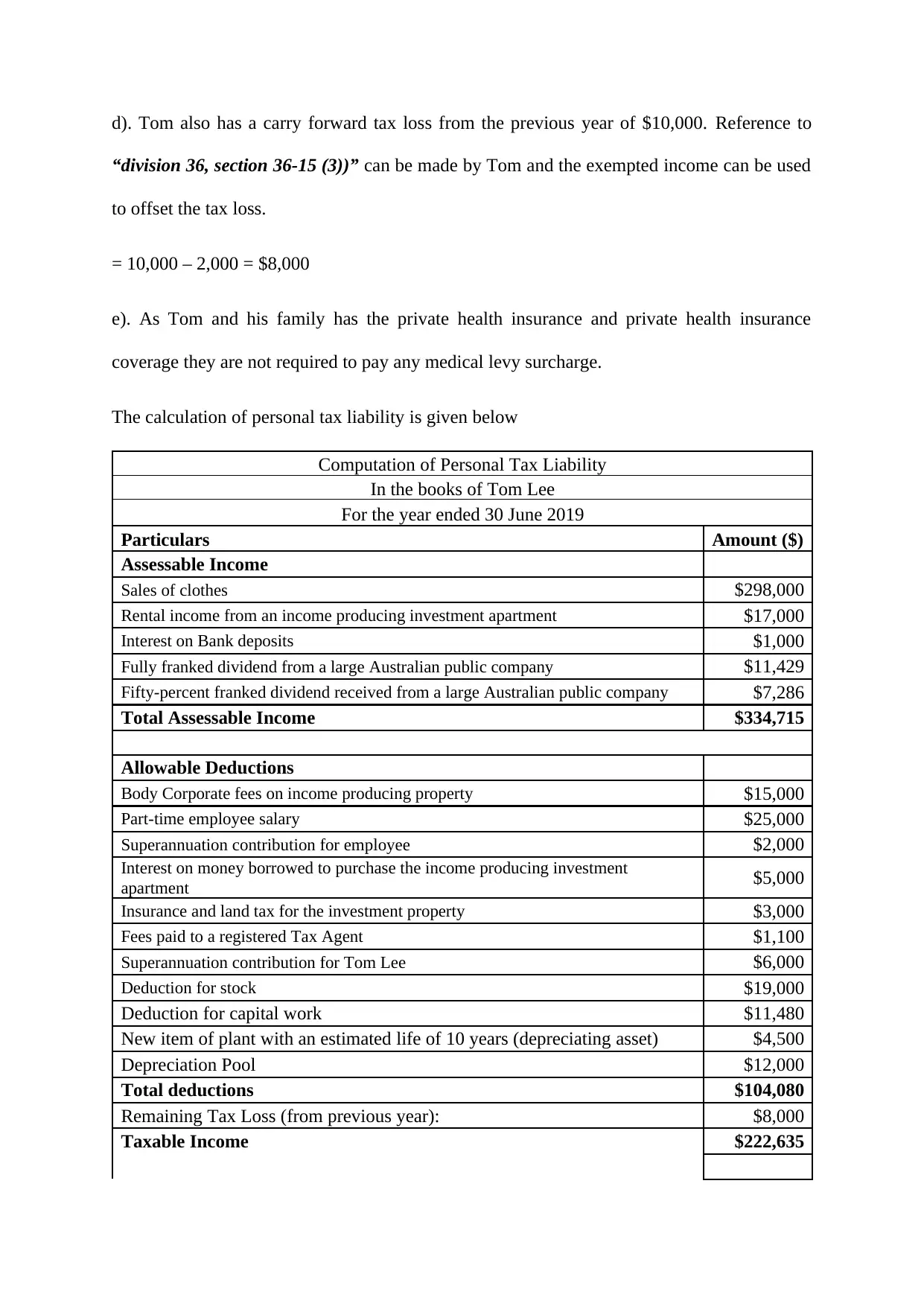
d). Tom also has a carry forward tax loss from the previous year of $10,000. Reference to
“division 36, section 36-15 (3))” can be made by Tom and the exempted income can be used
to offset the tax loss.
= 10,000 – 2,000 = $8,000
e). As Tom and his family has the private health insurance and private health insurance
coverage they are not required to pay any medical levy surcharge.
The calculation of personal tax liability is given below
Computation of Personal Tax Liability
In the books of Tom Lee
For the year ended 30 June 2019
Particulars Amount ($)
Assessable Income
Sales of clothes $298,000
Rental income from an income producing investment apartment $17,000
Interest on Bank deposits $1,000
Fully franked dividend from a large Australian public company $11,429
Fifty-percent franked dividend received from a large Australian public company $7,286
Total Assessable Income $334,715
Allowable Deductions
Body Corporate fees on income producing property $15,000
Part-time employee salary $25,000
Superannuation contribution for employee $2,000
Interest on money borrowed to purchase the income producing investment
apartment $5,000
Insurance and land tax for the investment property $3,000
Fees paid to a registered Tax Agent $1,100
Superannuation contribution for Tom Lee $6,000
Deduction for stock $19,000
Deduction for capital work $11,480
New item of plant with an estimated life of 10 years (depreciating asset) $4,500
Depreciation Pool $12,000
Total deductions $104,080
Remaining Tax Loss (from previous year): $8,000
Taxable Income $222,635
“division 36, section 36-15 (3))” can be made by Tom and the exempted income can be used
to offset the tax loss.
= 10,000 – 2,000 = $8,000
e). As Tom and his family has the private health insurance and private health insurance
coverage they are not required to pay any medical levy surcharge.
The calculation of personal tax liability is given below
Computation of Personal Tax Liability
In the books of Tom Lee
For the year ended 30 June 2019
Particulars Amount ($)
Assessable Income
Sales of clothes $298,000
Rental income from an income producing investment apartment $17,000
Interest on Bank deposits $1,000
Fully franked dividend from a large Australian public company $11,429
Fifty-percent franked dividend received from a large Australian public company $7,286
Total Assessable Income $334,715
Allowable Deductions
Body Corporate fees on income producing property $15,000
Part-time employee salary $25,000
Superannuation contribution for employee $2,000
Interest on money borrowed to purchase the income producing investment
apartment $5,000
Insurance and land tax for the investment property $3,000
Fees paid to a registered Tax Agent $1,100
Superannuation contribution for Tom Lee $6,000
Deduction for stock $19,000
Deduction for capital work $11,480
New item of plant with an estimated life of 10 years (depreciating asset) $4,500
Depreciation Pool $12,000
Total deductions $104,080
Remaining Tax Loss (from previous year): $8,000
Taxable Income $222,635
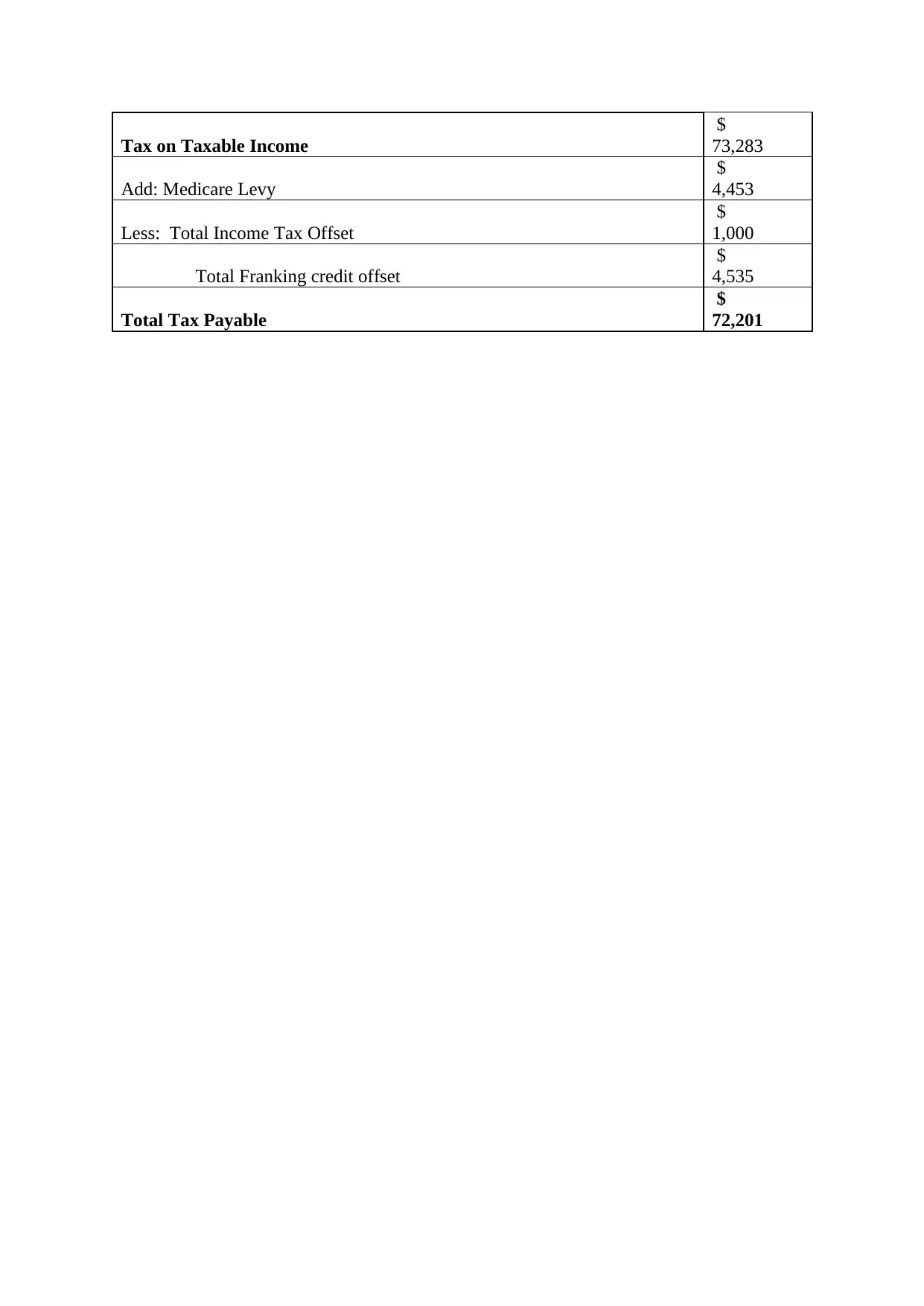
Tax on Taxable Income
$
73,283
Add: Medicare Levy
$
4,453
Less: Total Income Tax Offset
$
1,000
Total Franking credit offset
$
4,535
Total Tax Payable
$
72,201
$
73,283
Add: Medicare Levy
$
4,453
Less: Total Income Tax Offset
$
1,000
Total Franking credit offset
$
4,535
Total Tax Payable
$
72,201
1 out of 6
Related Documents
Your All-in-One AI-Powered Toolkit for Academic Success.
+13062052269
info@desklib.com
Available 24*7 on WhatsApp / Email
![[object Object]](/_next/static/media/star-bottom.7253800d.svg)
Unlock your academic potential
© 2024 | Zucol Services PVT LTD | All rights reserved.




